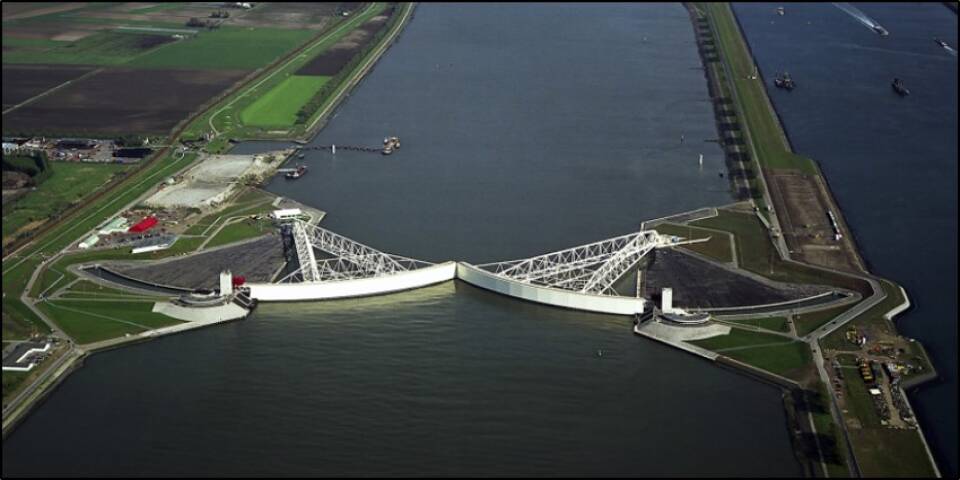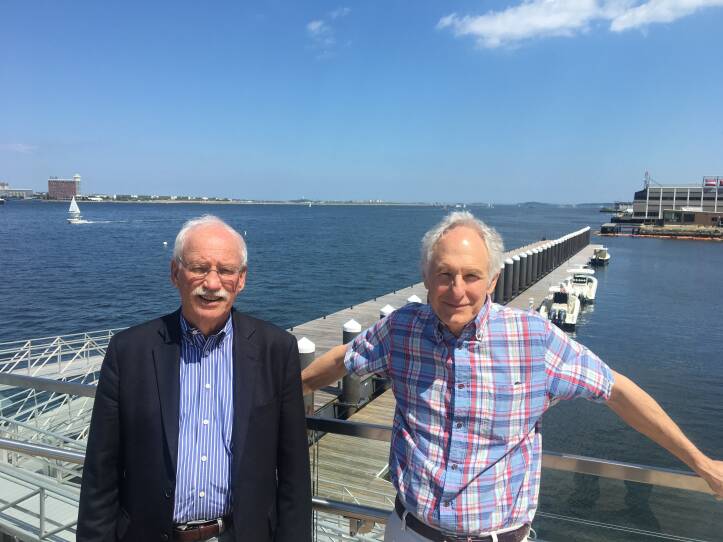A report released Wednesday says it’s not worth spending billions of dollars on a harbor-wide barrier wall to prevent coastal flooding in Boston. Improving aspects of the shoreline, the report says, would be a more cost-effective way to protect the city.
The report was commissioned by the Boston Green Ribbon Commission, which has been working with the city on strategies to fight climate change. It was funded by the Barr Foundation.
UMass Boston Professor Paul Kirshen, who led the study, walked down the boardwalk along South Boston’s Fan Pier next to the federal courthouse on Tuesday and pointed across the channel to the airport.
“The inner barrier would essentially stretch across the water from Logan over to around this area here,” he said. The inner harbor barrier was one of the options Kirshen’s team studied in the new report. “It’d be sort of like a stone, rock-covered structure,” he said. “But because this distance is so short, most of the system would actually be a large gate.”
That system is estimated to cost about $7 billion.
“So it's very expensive,” Kirshen said. His UMass team was tasked with figuring out if it’s worth it to spend that much.
In addition to the inner harbor barrier, they looked at another barrier farther out. As he stood on Fan Pier, Kirshen pointed off to the left where that outer barrier would start, at Deer Island. “And then it would swing around those islands there and then swing around to Hull,” he said. That’s a distance of about four miles, which would make it the longest such barrier in the world, at a cost nearly $12 billion.
Kirshen said as they looked at the feasibility of a barrier wall, they needed to make sure it would protect the city from flooding, preserve water quality in the harbor, and allow for shipping and boating.
They looked at three options to see if any of them could meet all those goals. One idea was a dike that would stretch all the way from the North Shore to the South Shore. But that didn’t meet any of the goals. And both the inner and outer harbor barriers had their own challenges.

For example, the inner harbor barrier would restrict the flow of water out of the harbor. “Because during a storm it might be closed as long as a couple of days, all the freshwater would build up behind it,” Kirshen said. “And unfortunately, a lot of the freshwater that comes into Boston Harbor during a storm is polluted.”
And both the inner and outer barriers would be tough for boats, because the barriers would not reduce the tidal flow.
“It would increase the velocity of water going through the gate openings,” he said. That’s because there would be a smaller opening, but the same amount of water going through.
Also, there’s some question about how long those gates would even work, since they’d likely have to be closed more and more often as sea levels continue to rise. “Eventually you might be closing it like every week,” he said. And the way these gates are engineered, they're not designed to be closed weekly. I mean they're mostly designed to be closed a couple of times a decade.”

The report says a more cost-effective way to protect the city would be to invest in measures along the shoreline, like building up protective berms or creating floodable green space.
“The outcome of this is it’s reaffirming the city is doing the right thing by focusing on these shore-based systems along the inner harbor waterfront,” said Bud Ris of the Boston Green Ribbon Commission. “That’s exactly what they need to be doing.”

And in places where buildings are right up against the shore, Ris said it may be time to consider expanding land into the harbor. “There's sort of been a prohibition on any more filling in Boston Harbor,” he said. “However, for resilience purposes I think we have to rethink some of that.”
In the next two years or so, we’re going to see a shift from just planning these things to actually doing them, Ris said. “Where are we going to start to build these shore-based systems along those inner harbor waterfronts, and how are we going to pay for it are going to be the next big questions.”
At the same time, Kirshen said, we’re going to need to keep our focus on reducing the greenhouse gases that are causing climate change. If we can get control of that, he said, we could hold sea level rise in Boston to two feet this century. If not, at the rate we’re going, he said, we could see up to 10 feet.





